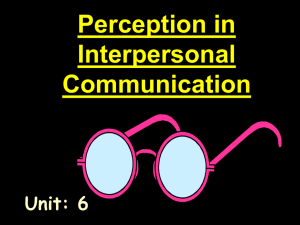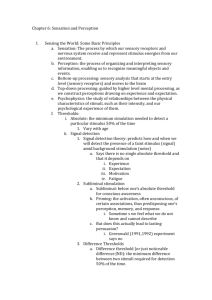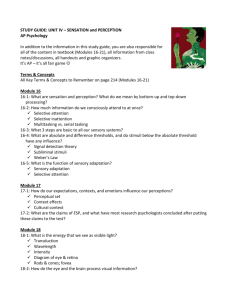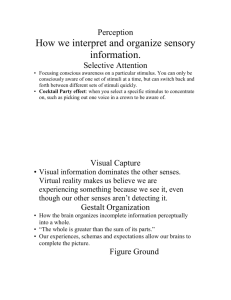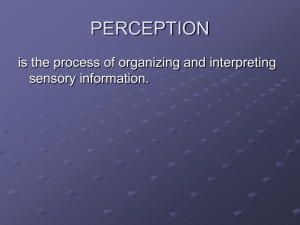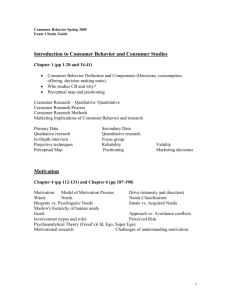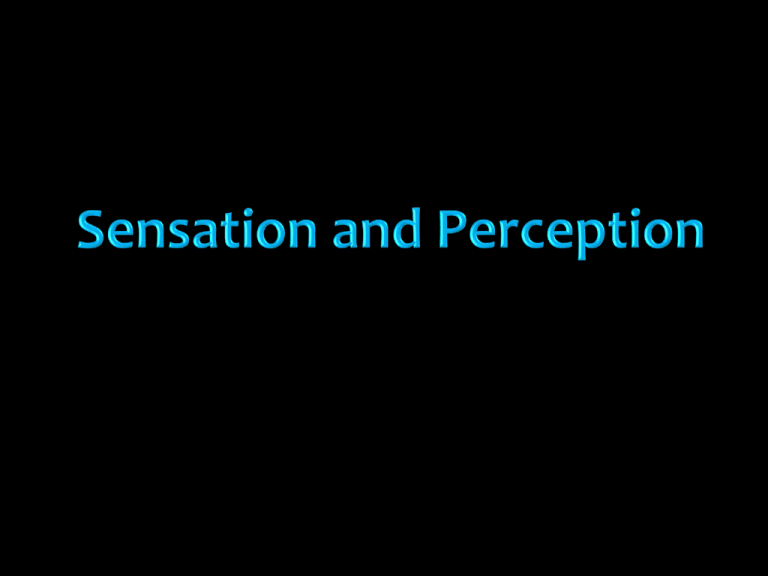
What is sensation?
The process by which our sensory
receptors and nervous system receive
stimulus from the environment.
Is it magic? You be the judge. Check out the
following exercise, guaranteed to raise an
eyebrow.
There's no trick or surprise. Just follow these
instructions, and answer the questions one at a
time
and as quickly as you can! Again, as quickly as you
can, but don't advance until you've done each of
them... really. Now, arrow down (but not too fast,
you might miss something).........
What is:
1+5
2+4
3+3
4+2
5+1
Now repeat saying the number 6 to
yourself as
fast
as
you can for 15 seconds.
QUICK!!! THINK OF A
VEGETABLE!
You're thinking of a carrot, right?
If you weren't thinking of a carrot,
you're among the 2% of the population
whose minds are different enough
to think of something else.
98% of people will answer with carrot
when given this exercise.
Freaky, huh?
Try it on people you know and
see if they are usual or unusual.
name a two digit odd number between one and
fifty, no two digits the same'
Did you pick 37
35% of the mass of people always choose '37'
Transduction
is the process of converting physical energy into
electrochemical codes.
Bottom-up processing: we start with the sensory
receptors sand work up to higher levels of processing.
Bottom-up processing: we start with the sensory
receptors sand work up to higher levels of
processing.
The human fovea can only focus on a very small area at one time
We fixate on one location for a moment and then move on to the next fixation. We
take in little at each fixation and it’s through a pattern of saccades that we take in
our visual environment.
Top-Down Processing The top-down process is
driven by prior knowledge and expectations as well as
our specific goals of the moment.
Suppose though, I asked you to find all the occurrences of the letter “P” in the
image? Now as you scan the image the letter “P” should start to stand out a bit
more and it’s possible that even the highly visible red letters start to fade into the
background. At the very least you likely aren’t noticing the words they spell out.
You see more of what you’re looking for and less of what you
aren’t.
Comics and cartoons provide many examples of top-down processing.
Simple cues are used to suggest complex feelings and emotions.
Cartoonists have a set of conventions for conveying information about
mental and physical states. Tiny popping bubbles, for example, show
drunkenness. Movement is shown by lines and little puffs of dust trailing
after shoes. Spoken language is shown inside a bubble made out of a
continuous line. A silent thought is shown inside a broken line. A sudden
idea may be shown as a lightbulb lighting up over a character's head. Beads
of sweat flying off a character show anxiety or physical exertion. After one
gains some experience reading comics, these cues are processed
automatically; one is hardly aware of them.
In many situations, however, your
knowledge or expectations will
influence perception. This is called
schema-driven or top-down
processing. A schema is a pattern
formed earlier in your experience.
In the figure Bottom-up processing enables our
sensory systems to detect the lines, angles and colors
that form the horses, rider and surroundings.
Using Top-down Processing we consider the
paintings title, notice the apprehensive expressions
and then direct our attention to aspects of the
painting that will give those observations meaning.;
Senses are nature’s gift that suit an organism’s
needs.
A frog feeds on flying insects; a male silkworm
moth is sensitive to female sex-attractant odor; and
we as human beings are sensitive to sound
frequencies that represent the range of human
voice.
Life would hurt.
So we can only take in a window of what is
out there.
This is the study of psychophysics.
Absolute
Threshold
Intensity
No
No
No
Yes
Yes
Observer’s Response
Detected
Tell when you (the observer) detect the light.
Difference Threshold
minimum difference between two stimuli required for detection
50% of the time
Or also called the JND just noticeable difference (JND)
Subliminal Threshold: When
stimuli are below one’s
absolute threshold for
conscious awareness.
Kurt Scholz/ Superstock
Absolute Thresholds for Humans
SENSE
STIMULUS
RECEPTORS
THRESHOLD
A candle flame
viewed from a
distance of about 30
miles on a dark night
Vision
Electromagnetic
Energy
Rods & Cones in the
retina
Hearing
Sound Waves
Hair cells of the inner The ticking of a
ear
watch from about 20
feet away in a quiet
room
Smell
Chemical substances
in the air
Receptor cells in the
nose
About one drop of
perfume diffused
throughout a small
house
Taste
Chemical substances
in saliva
Taste buds on the
tongue
About 1 teaspoon of
sugar dissolved in 2
gallons of water
Touch
Pressure on the skin
Nerve endings in the
skin
The wing of a fly
falling on a cheek
from a distance of
about 0.4 inches
The idea that, to perceive a difference
between two stimuli, they must differ by a
constant percentage; not a constant amount.
Predicts how and when we detect the presence
of a faint stimulus (signal) amid background
noise (other stimulation). SDT assumes that
there is no single absolute threshold and
detection depends on:
Carol Lee/ Tony Stone Images
Person’s experience
Expectations
Motivation
Level of fatigue
Diminished sensitivity as a consequence of
constant stimulation.
Put a band aid on your arm and after awhile
you don’t sense it.
The focusing of conscious awareness on
a particular stimulus.
Cocktail Party Effect: ability to listen to one
voice among many…to pay attention despite
distractions.
Kittens raised without
exposure to horizontal
lines later had difficulty
perceiving horizontal
bars.
Pick any number, 1 to 9.
Multiply by 9.
Add the 2 digits together.
If you still have two digits, add them again
Take away 5.
If A=1, B=2, C=3, assign a letter to your number.
Name a country starting with D
Pick the second letter in your country
Name an animal starting with that letter
Tell me the color of that animal
Gray
Mass Psychology
Pick any number, 1 to 9.
Multiply by 9.
Add the 2 digits together.
If you still have two digits, add them again (it'll always give 9).
Take away 5. (4)
If A=1, B=2, C=3, assign a letter to your number.
Name a country starting with D (options: Denmark, Djibouti, Dominica,
Dominican Republic), and seeing as it'll probably take a while to figure out a
country, people will pick the first one they think of (Denmark)
Pick the second letter in your country (E)
Name an animal starting with E (Elephant is most obvious)
Tell me the colour of that animal (Gray).
Perception
a process of organizing and interpreting
sensory information, enabling us to
recognize meaningful objects and events
Stare at the black dot in the middle. You should see the outer edges of the circle fade away!
Although it seems the brain interacts
directly with the outside world, it does not.
The brain senses the world indirectly
because the sense organs convert
stimulation into the language of the
nervous system: neural messages.
In short, the brain never receives stimulation
directly from the outside world.
In all the sense organs, it is the
job of sensory receptors to
convert incoming stimuli
information into electrochemical
signals—neural activity.
Transduction: The sensory
process that converts energy,
such as light or sound waves, into
the form of neural messages.
Transduction
with Hearing
Sensation and Perception
Focusing conscious awareness on a
particular stimulus to the exclusion of
others
The ability to focus on one stimulus
at a time
Allows a person to function in a
world filled with many stimuli
People with ADD have trouble doing
this.
Cocktail Part Effect: ability to listen to one voice
among many.
Change blindness is a form of inattentional
blindness in which two-thirds of individuals giving
directions failed to notice a change in the
individual asking for directions.
© 1998 Psychonomic Society Inc. Image provided courtesy of Daniel J. Simmons.
58
Two Major Theories
Three types of cones:
Red
Blue
Green
These three types of
cones can make millions of
combinations of colors.
Does not explain
afterimages or color
blindness well.
Opponent-Process Theory- opposing retinal
processes enable color vision
“ON”
“OFF”
red
green
green
red
blue
yellow
yellow
blue
black white
white
black
The sensory receptors
come in pairs.
Red/Green
Yellow/Blue
Black/white
If one color is
stimulated, the other is
inhibited.
Opponent
Processing Theory
Does this make your eyes all
weird out??
Opponent processing theory: we see in pairs
Afterimage is where you see the
image afterwards.
Psychology, 4/e by Saul Kassin ©2004
Prentice Hall
Stare at the eye of the red parrot while you count slowly to 20, then look immediately at one spot in the
empty bird cage. The faint, ghostly image of a blue green bird will appear in the cage.
Try the same thing with the green cardinal. A faint magenta bird will appear in the cage.
The ghostly birds you see here are called afterimages. An afterimage is an image that stays with you even after
you have stopped looking at an object. The back of your eye is lined with light sensitive cells, called cones, which
are sensitive to certain colors of light. When you stare at the red bird, your red-sensitive cones adapt to the light
and lose their sensitivity. When you shift your gaze to the white background of the bird cage, you see white
(minus red) where the red-sensitive cells have become adapted. White light minus red light is blue-green light.
That's why the afterimage you see is blue-green and in the shape of a parrot. The same thing happens when you
stare at the green bird, but this time it's the green-sensitive cones that adapt. White minus green light is magenta
light, so you see the afterimage as a magenta cardinal.
http://www.michaelbach.de/ot/col_lilacChaser/index.html
Perception is essentially an interpretation and
elaboration of sensation. Therefore, sensation refers to
the initial steps in the processing of a stimulus.
These pictures should
look similar
The True Picture
Let us try something out:
You are about to witness the perpetrator of a crime!
Describe what you saw. Keep in mind, that
this is a police investigation and that your
testimony can be used in a court of law.
1 . P a s t e x p e rie n c e s
“ S t a r s p a n g le d _ _ _ _ _ _ _ _ _ _ _ _ _ _ ”
2 . M o o d s , A t t it u d e s , a n d V a lu e s
H a v i n g a b a d d a y a n d “ th in g s ” s e e m t o s n o w b a ll
3. Needs
I f y o u ’ r e h u n g r y , y o u t h in k a b o u t…
4. What the group believes
W e h a v e a t e n d e n c y t o , “ g o a lo n g w i t h th e c r o w d .”
S E E IN G – H E A R IN G – T O U C H IN G – T A S T IN G – S M E L L I N G
Perceptual Set
is a tendency to perceive or notice some
aspects of the available sensory data and
ignore others.
What is seen in the center figures depends on the
order in which one looks at the figures:
If scanned from the left, a man’s face is seen.
If scanned from the right, a woman’s figure is seen.
Psychology, 4/e by Saul Kassin ©2004
Prentice Hall
Perceptual Set
is a tendency to perceive or notice some
aspects of the available sensory data and
ignore others.
Perceptual Set
is a tendency to perceive or notice some
aspects of the available sensory data and
ignore others.
Bruner & Minturn, 1955 illustrated how expectation could influence
set by showing participants an ambiguous figure '13' set in the
context of letters or numbers e.g.
The physical stimulus '13' is the same in each case but is perceived differently
because of the influence of the context in which it appears. We EXPECT to see a
letter in the context of other letters of the alphabet, whereas we EXPECT to see
numbers in the context of other numbers.
If the sounds do not work click here for link.
Illusions provide good examples in
understanding how perception is organized.
Studying faulty perception is as important as
studying other perceptual phenomena.
Line AB is longer than line BC.
The images are exactly the same except for the thick black area in the right image (an
example of the Poggendorff illusion (1860)). In the figure on the right, there appear to
be two continuous diagonal lines: a red and a blue line. What occurs in your visual
system that could account for the appearance of the continuous diagonal lines?
Reprinted with kind permission of Elsevier Science-NL. Adapted from
Hoffman, D. & Richards, W. Parts of recognition. Cognition, 63, 29-78
It takes a great deal of effort to perceive this figure in
two dimensions.
When vision competes with our other senses,
vision usually wins – a phenomena called visual
capture.
How do we form meaningful perceptions from
sensory information?
We organize it. Gestalt psychologists showed that a
figure formed a “whole” different than its
surroundings.
A specially-built room that
makes people seem to
change size as they move
around in it
The room is not a
rectangle, as viewers assume
it is.
A single peephole prevents
using binocular depth cues.
Psychology, 4/e by Saul Kassin ©2004
Prentice Hall
The image above is constructed from about 7,000 randomly placed dots. In a sequence
of frames, the dots in a square were randomized again, such that each of the
subsequent frames has a different randomization pattern in a selected square area.
The squares selected for randomization were constructed from 1/10 of the X and Y
values progressively from the lower left to the upper right along the diagonal of the
matrix. Dots change randomly within the succession of squares, but no dots move
along the diagonal, despite the appearance that they do.
Perceptual Adaptation
(vision) ability to adjust to an
artificially displaced visual field
prism glasses
Perceptual Set
a mental predisposition to perceive
one thing and not another
What you see in the
center is influenced
by perceptual set
Life would hurt.
So we can only take in a window of what is out
there.
This is the study of psychophysics: relationship
between physical stimuli and our psychological
experiences to them.
Flying Saucers or Clouds?
We need both of our
eyes to use these cues.
Retinal Disparity (as an
object comes closer to us,
the differences in images
between our eyes becomes
greater.
Convergence (as an
object comes closer our
eyes have to come
together to keep focused
on the object).
Organization of the visual field into objects
(figures) that stand out from their surroundings
(ground).
Time Savings Suggestion, © 2003 Roger Sheperd.
Perceptual Organization
Gestalt Laws of Grouping
Proximity
Seeing 3 pair of lines in A
Similarity
Seeing columns of orange
and red dots in B
Continuity
Seeing lines that connect 1
to 2 and 3 to 4 in C
Closure
Seeing a horse in D
Psychology, 4/e by Saul Kassin ©2004
Prentice Hall
1.
Closure
2.
Proximity
3.
Continuity
4.
similarity
Proximity
Gestalt
grouping
principles are at
work here.
Do you see
triangles?
Gestalt
grouping
principles are at
work here.
Although grouping principles usually help us construct
reality, they may occasionally lead us astray.
Both photos by Walter Wick. Reprinted from GAMES
Magazine. .© 1983 PCS Games Limited Partnership
The General's Family
There are 9 people in this picture,
called The Generals Family, which
is a work by the Mexican artist
Octavio Ocampo. There are nine
different faces in this picture
combining to make up the face of
the General and to tell the story
and the secrets of his life.
Although perceived as a
distinguished gentleman of solid
stock, the images of his past
betray his emergence from a
peasant family and his
impoverished beginnings. We see
his mother and father, his wife
and other members of his family,
even his dog (masquerading as
his hand) and as you study the
painting you see behind the
facade and read the story of a
remarkable life...
Innervisions
Depth perception enables us to judge distances.
Gibson and Walk (1960) suggested that human
infants (crawling age) have depth perception. Even
newborn animals show depth perception.
Visual Cliff
Retinal disparity: Images from the two eyes differ. Try
looking at your two index fingers when pointing them
towards each other half an inch apart and about 5 inches
directly in front of your eyes. You will see a “finger
sausage” as shown in the inset.
Convergence: Neuromuscular cues. When two
eyes move inward (towards the nose) to see near
objects and outward (away from the nose) to see
faraway objects.
Relative Size: If two objects are similar in size, we
perceive the one that casts a smaller retinal image
to be farther away.
Interposition: Objects that occlude (block) other
objects tend to be perceived as closer.
Rene Magritte, The Blank Signature, oil on canvas,
National Gallery of Art, Washington. Collection of
Mr. and Mrs. Paul Mellon. Photo by Richard Carafelli.
Relative Clarity: Because light from distant objects
passes through more light than closer objects, we
perceive hazy objects to be farther away than
those objects that appear sharp and clear.
Texture Gradient: Indistinct (fine) texture signals
an increasing distance.
© Eric Lessing/ Art Resource, NY
Relative Height: We perceive objects that are higher in our
field of vision to be farther away than those that are lower.
Image courtesy of Shaun P. Vecera, Ph. D.,
adapted from stimuli that appered in Vecrera et al., 2002
Relative motion: Objects closer to a fixation point
move faster and in opposing direction to those
objects that are farther away from a fixation point,
moving slower and in the same direction.
Linear Perspective: Parallel lines, such as railroad
tracks, appear to converge in the distance. The
more the lines converge, the greater their
perceived distance.
© The New Yorker Collection, 2002, Jack Ziegler
from cartoonbank.com. All rights reserved.
Light and Shadow: Nearby objects reflect more light into
our eyes than more distant objects. Given two identical
objects, the dimmer one appears to be farther away.
From “Perceiving Shape From Shading” by Vilayaur
S. Ramachandran. © 1988 by Scientific American, Inc.
All rights reserved.
The distant monster (below, left) and the top red
bar (below, right) appear bigger because of
distance cues.
Alan Choisnet/ The Image Bank
From Shepard, 1990
Perceptual Constancies
Shape Constancy Have you ever
noticed, for example, when you approach
the dinner table that the shapes of the
plates do not change? When you look at
them from some distance away from the
table, the shapes of the round plates are
elliptical on your retina. The only time that
the image of a round plate is approximately
round on your retina is when you look at it
straight on. If you are not sure what I mean,
look at the dinner plate demo.
Psychology, 4/e by Saul Kassin ©2004
Prentice Hall
Perceiving objects as unchanging even as
illumination and retinal images change. Perceptual
constancies include constancies of shape and size.
Shape Constancy
Kittens raised without
exposure to horizontal
lines later had
difficulty perceiving
horizontal bars.
Blakemore & Cooper (1970)
Courtesy of Hubert Dolezal
Visual ability to adjust to
an artificially displaced
visual field, e.g., prism
glasses.
Face schemas are accentuated by specific
features on the face.
Kieran Lee/ FaceLab, Department of Psychology,
University of Western Australia
Students recognized a caricature of Arnold
Schwarzenegger faster than his actual photo.
Eyes and mouth play a dominant role in face
recognition.
Courtesy of Christopher Tyler
Portrait artists understood the importance of this recognition and
therefore centered an eye in their paintings.
Context instilled by culture also alters
perception.
To an East African, the woman sitting is balancing a metal
box on her head, while the family is sitting under a tree.
Understanding human factors enables us to design
equipment to prevent disasters.
Two-thirds of airline crashes caused by human error are
largely due to errors of perception.
Extrasensory Perception
controversial claim that perception can occur apart from sensory input
telepathy
clairvoyance
precognition
Parapsychology
the study of paranormal phenomena
ESP
psychokinesis
Telepathy: Mind-to-mind communication. One
person sending thoughts and the other
receiving them.
2. Clairvoyance: Perception of remote events, such
as sensing a friend’s house on fire.
3. Precognition: Perceiving future events, such as a
political leader’s death.
1.
Can psychics see the future? Can psychics aid
police in identifying locations of dead bodies?
What about psychic predictions of the famous
Nostradamus?
The answers to these questions are NO!
Nostradamus’ predictions are “retrofitted” to
events that took place after his predictions.
In an experiment with 28,000 individuals,
Wiseman attempted to prove whether or not one
can psychically influence or predict a coin toss.
People were able to correctly influence or predict a
coin toss 49.8% of the time.
Below one’s absolute threshold for conscious
awareness.
Show clip
Does this work?
Yes and No
•Slide studies showed some emotional react
(called priming a response).
•The effects are subtle and fleeting.
Stimuli below our absolute threshold.
Backmasking
25th frame
Do Subliminal Messages work?
Probably a placebo effect
1) The Pepsi Cool Can
In 1990, Pepsi actually withdrew one of its “Cool Can” designs after someone protested that Pepsi
was subliminally manipulating people by designing the cans such that when six-packs were stacked
at grocery stores, the word SEX would emerge from the seemingly random design. Critics alleged
that the red and blue lines on the “Cool Can” design were far from random <27>.


